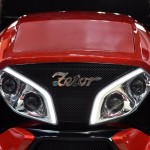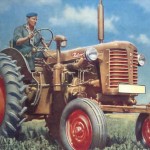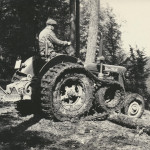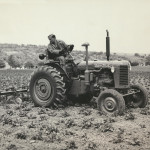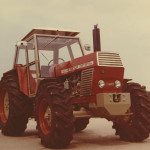The historic manufacturer of agricultural machinery has engaged Pininfarina to have a bit more sex appeal
The profile is sinuous and physical. Its lines are like those of an elegant Ferrari racing car. Even its bright red chrome finish is similar to that of the Maranello racing cars. But the vehicle in question is an agricultural machine that was not built for the race track. Yet, it was designed by the same skilful car designer, or better still, by the artist: the unmistakable Pininfarina, who, for the first time, has designed a vehicle for the farming sector. What the BBC described as the “world’s sexiest tractor” is actually the latest Zetor model, built by the historic Czech company, producer of agricultural machinery, that has decided to celebrate its seventieth anniversary in this way. Put on show at the prestigious agricultural exhibition in Hanover last November – Agritechnica, – the Brno company unveiled to the public its Italian design concept tractor that will enter into production in the coming months.
 Zetor, which has become a global symbol in the production of agricultural machinery – and famous for its well-consolidated mechanical efficiency – aims to gain new ground by investing also on the aesthetic aspect of their machines, whereas, traditionally, they had relied more on engineering reliability rather than producing a captivating style.
Zetor, which has become a global symbol in the production of agricultural machinery – and famous for its well-consolidated mechanical efficiency – aims to gain new ground by investing also on the aesthetic aspect of their machines, whereas, traditionally, they had relied more on engineering reliability rather than producing a captivating style.
But first, a little history
If Zetor is now proposing a new model, with an avant-garde style, it is also fair to remember that its legend was built over the years and on the basis of a long tradition spent on building reliable machines, with a good quality-price ratio. A blazon that dates back to the establishment of the Česká Zbrojovka foundry, that has been active in Brno since 1864, and whose factories have produced various things: heavy and lightweight weapons, cars and also motorcycles.
Though it was destroyed by allied bombing during World War II, the industrial area and its factories started production again after the conflict. Then, Česká Zbrojovka set up a collaboration agreement with the ploughs manufacturer Laurin & Klement: a successful initiative that opened the way to the important industrial production of agricultural machinery, that was soon marketed all over the world. In August 1946, the Zetor brand name was registered at the Czechoslovak Chamber of Commerce: the name derives from the fusion of the iconic Z (pronounced “Zet” in Czech) of the brand name Česká Zbrojovka, with the two last letters taken from the word “Tractor”.
Thus, it was through the language and in the factory that the made-in Czechoslovakia tractor history had its beginnings. The first historical model was the simple and solid Zetor 25, that was an immediate commercial success: the first prototype was developed in November 1945, while its mass production took place around a year later.
Those were the early years of the regime and the single party in Czechoslovakia. Inevitably, the new Zetor tractors became tools of propaganda. “A new large army is being formed. The Czechoslovak army of progressive farmers”, was the slogan used in the newsreels of the time – while black and white images of tractors and smiling farm workers were shown on the screen. And it was actually a brand new Zetor 25 model, that, in the summer of 1946, was given to the new premier (and soon president), Klement Gottwald, for his 50th birthday.
Setting out to conquer the world
Conceived originally as a vehicle intended to accelerate the mechanization of Czechoslovakian agriculture, the Zetor 25 was immediately appreciated and purchased both at home and abroad, especially in countries behind the Iron Curtain, and became a first-rate reference point for the agricultural mechanization of Soviet inspiration.
Its great success was favoured by the excellent mechanical standards of its tractors, as well as their price. The machines were built according to design principles derived from military equipment: the precision machining and interchangeable parts were easy to assemble and replace. All these features made the Z 25 a successful product.
All these qualities allowed Zetor to continue producing this model for several years, enabling it to reach a total production of about 158,000 machines, two thirds of which ended up across the border. The Zetor 25 was produced until 1961, the year in which the company decided to end the production of its first machine. However, the success of the Z 25 led the company to move its production to the state owned plant of Závody Přesného Strojírenství Brno-Líšeň in 1952. In the new factory, other models were added to the historic 25 model – such as the Zetor 35 and Zetor 50. All of them were equipped with four-stroke diesel engines and became very popular between the 1950s and 1960s, and for more than a decade were the products of excellence of the Czechoslovakian domestic industry. Czech tractors were exported all over the world: Europe, the United States, Cuba and India. Between 1951 and 1961, around 700 of them were sold on the Italian market. The success of the manufacturing company was consolidated during the next two decades, when the new Zetor 4511 and 2011 models were introduced and in the 1960s, the Brno company reached a significant increase in world market share in terms of sales of tractors and engines for agricultural machinery.
The new era
New models were then produced and the company continued to make profits until the year 2000, when Zetor got into serious financial difficulties and was forced to stop production temporarily. However, in view of the economic importance of the company for the region, the government decided to intervene and support the historic Brno company financially.
Two years later, the company was taken over by the Slovak Htc holding: business started growing again. Since 2000, the company has introduced new models and its sales have recovered substantially, with its machines exported to the five continents: Zetor now sells its tractors to more than 40 countries. With 1.2 million tractors sold since it was established, the Brno company is now celebrating its seventieth anniversary. In doing so, it has decided to put on its “best suit”: the model designed by Pininfarina, sums up all of Zetor’s resolutions for the coming years: to build machines that are as strong as military tanks, but at the same time, as glamorous as Ferrari racing cars.
by Edoardo Malvenuti





